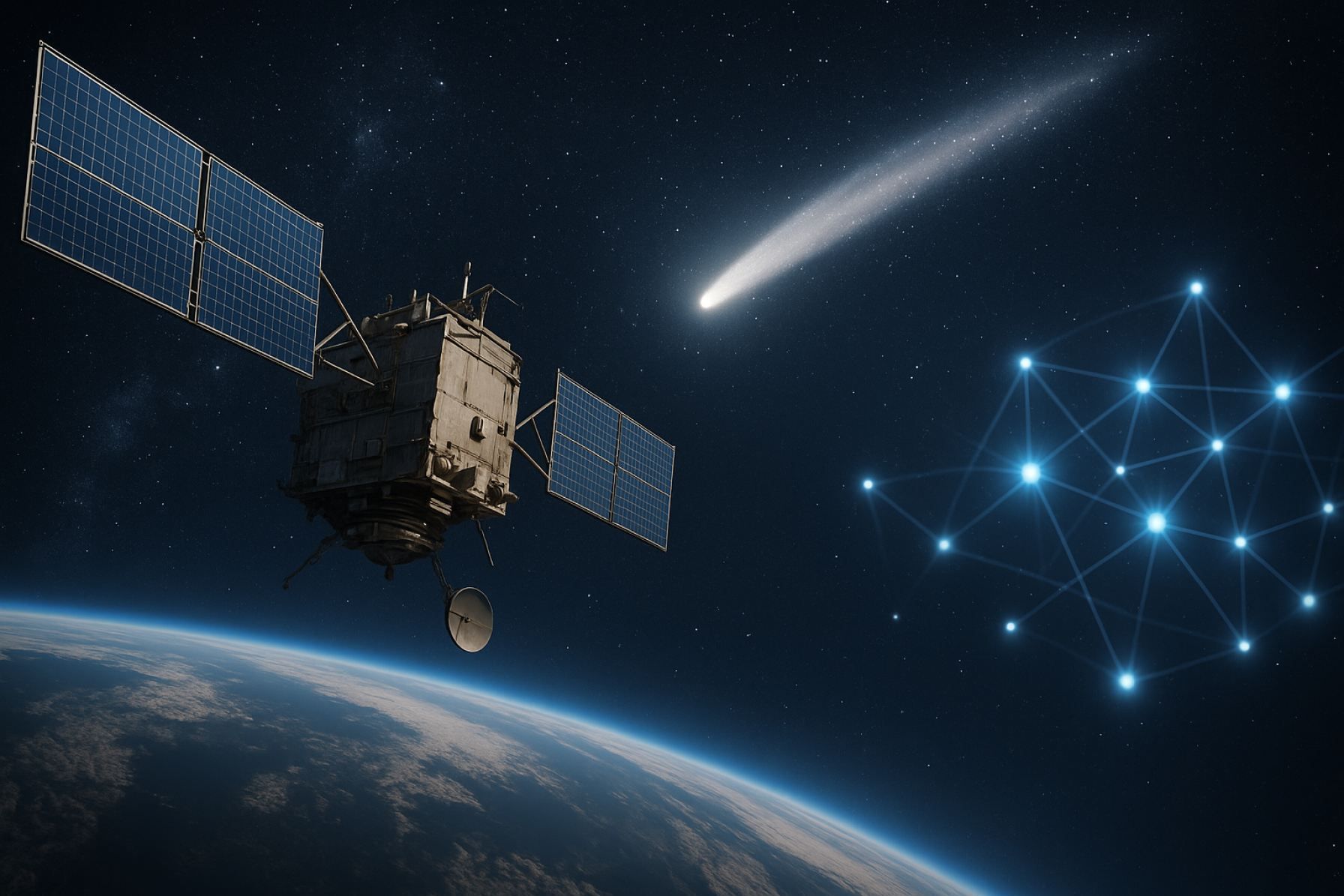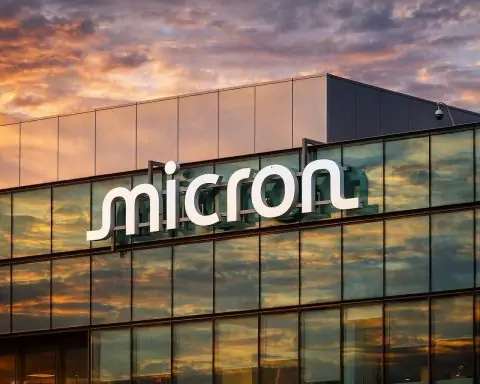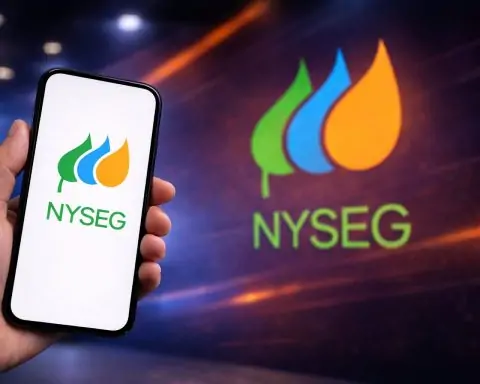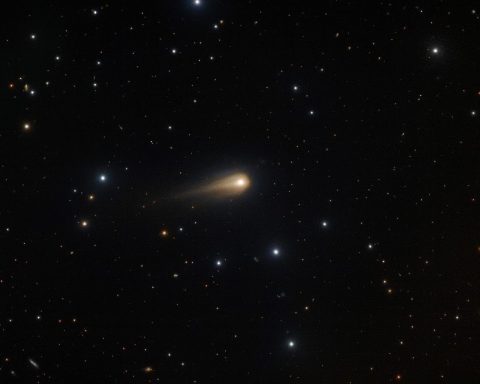- Boeing won a $2.8 billion U.S. Space Force contract to develop two Evolved Strategic Satellite Communications (ESS) satellites, with options for two more, for NC3 in geostationary orbit, with first delivery targeted for 2031.
- MethaneSAT, a $134 million satellite funded by the Environmental Defense Fund and Jeff Bezos’ Earth Fund, was lost after 15 months in orbit, ending methane-emission monitoring that had revealed some regions emit up to 10 times higher than prior estimates.
- ESA launched MTG-S1, the first geostationary meteorological sounder, alongside Copernicus Sentinel-4 to deliver real-time high-resolution atmospheric data for Europe.
- NASA’s Mars Reconnaissance Orbiter, in operation since 2006, is executing 120-degree rolls to enhance radar scans of subsurface water ice.
- Comet 3I/ATLAS (C/2025 N1), the third known interstellar object, was detected by NASA’s ATLAS telescope and will pass about 150 million miles from Earth in October at a speed of 68 km/s.
- Amazon’s Kuiper plans a 3,232-satellite low-Earth orbit broadband constellation delivering 100 Mbps to 1 Gbps, with rollout in 2025 to North America and Europe.
- Congress approved nearly $10 billion for NASA’s Artemis program, while a Government Accountability Office audit found Artemis accounts for over half of NASA’s recent $500 million cost overruns, largely due to the Orion capsule.
- The relocation of NASA’s Space Shuttle Discovery from the Smithsonian Udvar-Hazy Center to Space Center Houston could cost up to $300 million, far exceeding the $85 million allocated.
- SpeQtral and Thales Alenia Space expanded their partnership to demonstrate satellite-to-Earth quantum communications, testing entangled photon transmission between the SpeQtral-1 satellite and a ground station toward global quantum networks.
- The UK Space Agency opened a £75.6 million tender for its first active debris removal mission to de-orbit two defunct UK-licensed satellites by 2028.
Space News Roundup: Strategic Satellites, Interstellar Visitors, Quantum Networks, and More
The first week of July 2025 has delivered a torrent of developments across the global space sector. From billion-dollar military satellite contracts and the discovery of a new interstellar comet, to the promise of quantum-secure communications and the heartbreak of a lost climate satellite, the headlines reflect a rapidly evolving, interconnected space ecosystem. This comprehensive review distills the most significant stories, their implications, and what to watch for next.Boeing’s $2.8 Billion ESS Satellite Win: A New Era for Strategic Communications
Boeing has secured a landmark $2.8 billion contract from the U.S. Space Force to develop and produce two Evolved Strategic Satellite Communications (ESS) satellites, with options for two more. These geostationary satellites will form the backbone of the U.S. military’s nuclear command, control, and communications (NC3) infrastructure, replacing the aging AEHF constellation and promising greater resilience, capacity, and cybersecurity.What Is ESS and Why Does It Matter?
ESS is designed to provide secure, jam-resistant, and resilient communications for the highest levels of U.S. military and government leadership, including the President. The satellites will operate in geostationary orbit, ensuring global, always-on coverage for critical command and control functions—even in the event of nuclear conflict or major cyberattacks.The contract, which could ultimately be worth up to $12 billion, is a major validation of Boeing’s satellite technology investments and cements its leadership in the strategic communications domain. According to Michelle Parker, Boeing’s Vice President of Space Mission Systems, “This victory validates all the investments and innovations… in our satellite technology.” [1]Key Details
- Contract Value: $2.8 billion for two satellites, with options for two more.
- Timeline: First satellite delivery by 2031.
- Mission: Nuclear command, control, and communications (NC3).
- Orbit: Geostationary.
- Resilience: Advanced cyber protection, anti-jamming, and assured connectivity in contested environments.
- Strategic Impact: ESS is “a key pillar of enduring nuclear deterrence strategy,” according to Col. A.J. Ashby of the U.S. Space Force.
Outlook
With rising global tensions and the increasing vulnerability of space assets to cyber and kinetic threats, the ESS program is a cornerstone of U.S. national security. Its success will likely influence allied procurement and spur further innovation in secure satellite communications worldwide.MethaneSAT: A Climate Monitoring Setback
In a blow to global climate monitoring efforts, MethaneSAT—a $134 million satellite funded by the Environmental Defense Fund and Jeff Bezos’ Earth Fund—has been declared lost after just 15 months in orbit. The satellite, which played a crucial role in tracking global methane emissions, went off course and lost power, with recovery now considered unlikely.The Mission and Its Loss
MethaneSAT was designed to provide precise, independent measurements of methane leaks from oil, gas, and agricultural sources worldwide. Its data revealed emissions up to 10 times higher than previously reported in some regions, making it a vital tool for climate policy and accountability. [3]Despite the loss, EDF’s Amy Middleton emphasized, “We’re seeing this as a setback, not a failure.” The mission’s scientific and technological achievements remain significant, and insurance is expected to cover the financial loss. [4]Implications
- Climate Monitoring: The loss leaves a gap in independent methane surveillance, though ESA’s Sentinel-5P and other satellites continue the work.
- New Zealand’s Space Ambitions: The failure is a particular blow to New Zealand, which had invested NZ$29 million and was about to assume mission control.
- Outlook: The incident underscores the risks of space-based climate monitoring and the need for redundancy in Earth observation constellations.
Quantum Communications: SpeQtral and Thales Alenia Space Lead the Charge
Quantum-secure communications are moving from theory to practice, thanks to a deepening partnership between Singapore-based SpeQtral and Europe’s Thales Alenia Space. Their joint program will test and demonstrate quantum key distribution (QKD) between the SpeQtral-1 satellite and a new ground station, paving the way for a global quantum internet.Why Quantum Networks Matter
Quantum communications promise virtually unbreakable encryption, as any attempt to intercept quantum keys disturbs the system and is immediately detectable. This is critical for government, defense, and financial sectors seeking to future-proof their data against quantum computing threats.The Collaboration
- Experiments: Entangled photon transmission, environmental impact studies, and interoperability testing.
- Goal: Validate technical foundations for secure, global quantum networks.
- Industry Impact: “This collaboration provides a structured framework to experiment, learn and move forward,” said Christophe Valorge, CTO at Thales Alenia Space.
Outlook
With satellite-based QKD, secure communications can leapfrog terrestrial infrastructure limitations, enabling continent-spanning quantum networks. The success of these experiments will be a bellwether for the future of cybersecurity in space and on Earth.Amazon Kuiper and Starlink: The Satellite Internet Race Heats Up
Amazon’s Project Kuiper is set to launch its satellite broadband service by late 2025 in major markets including France, Germany, the UK, US, and Canada. With an initial constellation of 3,232 satellites and user terminals offering speeds from 100 Mbps to 1 Gbps, Kuiper aims to challenge SpaceX’s Starlink and Eutelsat’s OneWeb in the rapidly growing LEO broadband sector.Key Features
- Launch Partners: Ariane 6 and SpaceX.
- Coverage: Initial focus on North America and Europe, with global expansion planned.
- User Terminals: Three models, catering to different speed and price points.
- Commercial Launch: Expected before the end of 2024 in France, with broader rollout in 2025.
Starlink’s Lead
Meanwhile, Starlink has been named the fastest in-flight satellite internet provider by Ookla, with average download speeds of 152 Mbps and latency as low as 44 ms—thanks to its low-Earth orbit architecture. [8]Outlook
The satellite broadband market is poised for explosive growth, with competition driving down prices and expanding access to underserved regions. Regulatory, spectrum, and orbital debris challenges remain, but the era of global, high-speed satellite internet is fast approaching.Mars Reconnaissance Orbiter: Daring Maneuvers, New Discoveries
NASA’s Mars Reconnaissance Orbiter (MRO), in orbit since 2006, is executing unprecedented 120-degree rolls to enhance its radar scans for subsurface water ice. These maneuvers, far beyond the spacecraft’s original design, have increased signal strength tenfold and are revolutionizing the search for resources critical to future Mars colonization.Scientific Impact
- Water Ice Mapping: Improved radar scans could pinpoint accessible ice deposits for future human missions.
- Engineering Feat: The risky maneuvers demonstrate the adaptability of aging spacecraft and the ingenuity of mission teams.
Outlook
MRO’s success sets a precedent for extending the utility of long-lived planetary missions through creative operations, maximizing scientific return on investment.Europe’s MTG-S1 and Sentinel-4: A Leap in Atmospheric Monitoring
The European Space Agency (ESA) has launched the Meteosat Third Generation Sounder 1 (MTG-S1) and Copernicus Sentinel-4, ushering in a new era of real-time, high-resolution atmospheric data for Europe.Mission Highlights
- MTG-S1: First geostationary meteorological sounder, providing high-frequency infrared atmospheric profiles.
- Sentinel-4: Monitors air quality and pollution, supporting public health and environmental policy.
- Impact: “These two groundbreaking missions are set to change the way we forecast both severe weather and the quality of air over Europe,” said ESA’s Simonetta Cheli.
Outlook
With climate change driving more frequent extreme weather, advanced satellites like MTG-S1 and Sentinel-4 are critical for early warnings, disaster preparedness, and long-term environmental stewardship.Interstellar Visitor: Comet 3I/ATLAS Blazes Through the Solar System
Astronomers have detected the third known interstellar object, comet 3I/ATLAS (C/2025 N1), streaking through our solar system at a record 68 km/s. Discovered by NASA’s ATLAS telescope, the comet is larger than previous interstellar visitors Oumuamua and 2I/Borisov, and will pass safely at 150 million miles from Earth in October.Why This Matters
- Scientific Opportunity: Studying 3I/ATLAS offers a rare glimpse into the composition and dynamics of objects from other star systems.
- Trajectory: Its hyperbolic path confirms its extrasolar origin.
- Excitement: “It’s just very exciting,” said Paul Chodas of NASA.
Outlook
As telescopes improve, more interstellar visitors are likely to be discovered, offering new insights into planetary system formation and the diversity of the galaxy.Space Shuttle Discovery Relocation: Controversy and Cost
A political and logistical storm is brewing over the proposed relocation of NASA’s Space Shuttle Discovery from the Smithsonian’s Udvar-Hazy Center in Virginia to Space Center Houston. The move, mandated by a provision in a recent federal bill, is estimated to cost up to $300 million—far more than the $85 million allocated.The Debate
- Supporters: Argue Houston, as a hub of human spaceflight, deserves a shuttle.
- Opponents: Cite high costs, risks to the artifact, and question the necessity of the move.
- Astronaut Voices: Former astronaut Garrett Reisman called the transfer “ludicrous and unnecessary,” suggesting funds be used for NASA’s science program instead.
Outlook
The controversy highlights the intersection of politics, regional pride, and the stewardship of national space heritage. The outcome will set a precedent for future artifact relocations.Quantum Satellite Communications: The Next Internet Revolution
The push for a quantum-secure internet is gaining momentum. SpeQtral and Thales Alenia Space’s expanded partnership aims to demonstrate satellite-to-Earth quantum communications, including entangled photon transmission and environmental impact studies. [13]Why It Matters
- Security: Quantum key distribution (QKD) is immune to eavesdropping, crucial for defense, finance, and critical infrastructure.
- Global Reach: Satellites can bridge continents, overcoming fiber optic limitations.
- Industry Leadership: Europe and Asia are racing to establish quantum-secure networks, with the U.S. also investing heavily.
Outlook
Successful demonstrations will accelerate the deployment of operational quantum satellites and ground stations, shaping the future of secure global communications.China’s Shiyan-28B: Expanding Space Capabilities
China continues its rapid expansion in space with the successful launch of the Shiyan-28B 01 satellite aboard a Long March 4C rocket. The mission, China’s 583rd Long March launch, underscores the reliability and versatility of its launch vehicles and the nation’s commitment to advancing satellite technology.Mission Details
- Purpose: Space environment detection and technology demonstration.
- Significance: Adds to China’s growing portfolio of experimental and operational satellites, reinforcing its status as a major space power.
Outlook
China’s sustained launch cadence and focus on both civil and military space assets position it as a formidable competitor in the new space race.NASA’s Artemis Program: Funding, Delays, and Criticism
Congress has approved nearly $10 billion in new funding for NASA’s Artemis moon program, supporting additional SLS rocket production and the Gateway lunar station. However, a Government Accountability Office audit found that Artemis is responsible for over half of NASA’s recent $500 million cost overruns, mainly due to the troubled Orion crew capsule.The Debate
- Supporters: Emphasize the importance of sustained lunar exploration and U.S. leadership.
- Critics: Figures like Elon Musk and Jared Isaacman argue for reusable rockets over the expendable SLS, citing cost and efficiency.
- International Impact: Cuts to Artemis or Gateway could harm Europe’s role in lunar exploration and disrupt key production lines.
Outlook
The Artemis program’s future will depend on its ability to control costs, integrate complex systems, and deliver on ambitious timelines amid growing commercial competition.Earth at Aphelion: Why Summer Is Still Hot
On July 3, 2025, Earth reached aphelion—its farthest point from the Sun at 152 million kilometers. Despite this, the Northern Hemisphere experiences peak summer heat due to Earth’s axial tilt, not its distance from the Sun.Key Points
- Axial Tilt: Causes longer days and more direct sunlight in summer.
- Orbital Effects: Earth moves slower at aphelion, making summer slightly longer in the Northern Hemisphere.
- Public Confusion: Many mistakenly link distance from the Sun to seasonal temperatures.
Outlook
Understanding the mechanics of Earth’s orbit is crucial for science education and climate literacy.Notable Astronomical Events and Observing Highlights
Mercury at Greatest Elongation
On July 4, Mercury reached its greatest eastern elongation, offering a rare opportunity for evening skywatchers to spot the elusive planet alongside a waxing crescent Moon in Gemini. [17]Meteor Fireballs Over Scotland
A spectacular meteorite fireball lit up the skies over Edinburgh and the Lothians, accompanied by a loud boom. The event, captured on doorbell cameras, sparked widespread amazement and social media buzz. [18]Novae in Vela and Lupus
Two novae—V572 Velorum and V462 Lupi—are currently visible to the naked eye from the Southern Hemisphere, a rare astronomical event last seen in 2018. [19]Supernova Breakthrough: First Double-Detonation Observed
Astronomers using ESO’s Very Large Telescope have, for the first time, observed a white dwarf star exploding twice in a single Type Ia supernova event (SNR 0509-67.5). This “double detonation” mechanism, involving an initial helium shell explosion followed by a core detonation, provides new insights into the origins of these cosmic mileposts.Scientific Impact
- Cosmology: Type Ia supernovae are used to measure cosmic distances; understanding their mechanisms refines these measurements.
- Stellar Evolution: Confirms that some Type Ia supernovae can occur before the white dwarf reaches the Chandrasekhar mass limit.
Satellite Connectivity: Saving Lives and Expanding Access
Emergency SOS via Satellite
A 53-year-old mountaineer in Colorado was rescued after using his iPhone’s Emergency SOS via satellite feature, highlighting the growing importance of direct-to-device satellite communications for emergency response. [21]T-Mobile and Starlink
T-Mobile will enable satellite texting for older phones via Starlink, following an FCC waiver. This expands emergency coverage to more devices, though the service is text-only and may incur a small fee. [22]Apple Watch Ultra 3
The upcoming Apple Watch Ultra 3 is expected to feature satellite connectivity and 5G, enabling independent messaging in low-signal areas—a significant upgrade for outdoor enthusiasts and emergency preparedness. [23]Space Debris and Environmental Concerns
Space Debris Removal
The UK Space Agency has launched a £75.6 million tender for its first active debris removal mission, aiming to de-orbit two defunct satellites by 2028. This initiative will advance in-orbit servicing and help secure the UK’s leadership in the space economy. [24]Satellite Collision Debris
A recent collision between U.S. and Russian communication satellites has created a debris field that could threaten space operations for years, underscoring the urgent need for improved space situational awareness and international cooperation. [25]SpaceX Debris on Mexican Beaches
Debris from SpaceX’s Starship rocket has washed up on Mexican beaches, raising concerns for endangered Kemp’s ridley sea turtles. Conservationists warn that debris may block hatchlings or compact sand, hindering emergence. [26]Earth Observation: Growth Driven by Defense and Sustainability
A Novaspace report projects that Earth observation satellite launches will triple in the next decade, reaching 5,770 units—86% of which will be constellation satellites. Defense demand and the need for national sovereignty are key drivers, alongside environmental monitoring and commercial applications. [27]ESA’s Biomass satellite has released its first stunning images, showcasing forests, deserts, and volcanoes, and will estimate Earth’s carbon storage over its five-year mission. [28]Human Spaceflight: Artemis, ISS, and Astronaut Stories
Artemis Funding and Challenges
Congress has approved a $10 billion boost for NASA’s Artemis program, ensuring continued reliance on SLS rockets and the Gateway lunar station despite criticism from commercial space leaders. [29]ISS Science and Culture
- Astronaut Nichole Ayers: Credits her Colorado roots for her journey to the ISS, where she is part of SpaceX Crew 10 and contributes to ongoing science experiments.
- French Cuisine in Space: ESA astronaut Sophie Adenot will enjoy gourmet meals by Michelin-starred chef Anne-Sophie Pic on her upcoming ISS mission, blending science and culture in orbit.
Other Notable Developments
- Rocket Lab USA: Secures institutional backing and defense contracts, positioning itself as a key player in next-gen space launches.
- ULA Vulcan Rocket: Begins stacking for its first national security mission, marking a new chapter for U.S. launch capabilities.
- Satellite ETF Growth: Satellite ETF (159206) saw a 15 million share increase, reflecting investor confidence in the commercial satellite sector.
- US Lifts Ethane Export Ban: Restores normal trade and stabilizes supply chains for Satellite Chemical and Wanhua Chemical.
Recap: Key Takeaways
- Strategic Security: Boeing’s ESS satellites will anchor U.S. nuclear command and control for decades.
- Climate Monitoring: MethaneSAT’s loss is a setback, but the mission’s data legacy endures.
- Quantum Leap: Satellite-based quantum communications are moving from lab to orbit.
- Internet Everywhere: Amazon Kuiper and Starlink are racing to connect the world.
- Science Frontiers: Interstellar comet 3I/ATLAS and double-detonation supernovae expand our cosmic understanding.
- Space Sustainability: Debris removal and environmental monitoring are urgent priorities.
- Human Touch: Astronaut stories and cultural initiatives keep space exploration relatable and inspiring.
Looking Ahead
The coming months will see:- The rollout of new satellite internet services and quantum communication tests.
- Continued debate over Artemis program costs and the future of lunar exploration.
- More launches from China, Europe, and commercial providers, intensifying the global space race.
- Ongoing challenges in space debris mitigation and environmental stewardship.
For further reading and detailed sources, see the links embedded throughout this article.
More today’s sources
Boeing to Supply Pentagon with Two Next-Gen Communication Satellites for $2.8 Billion
Boeing has secured a $2.8 billion contract with the US Department of Defense to develop and produce two next-generation ESS communication satellites. These geostationary satellites will provide secure communications for US nuclear command and control, with the first satellite ready by 2031. The contract includes an option for two additional satellites.
Continue reading on [36]
MethaneSAT, Bezos-backed Methane Tracking Satellite, Lost in Space
The $88 million MethaneSAT, a satellite funded by Jeff Bezos and operated by the Environmental Defense Fund, has been lost after going off course and losing power. MethaneSAT was pivotal in tracking global methane emissions. “We’re seeing this as a setback, not a failure,” said Amy Middleton, EDF senior vice president.
Continue reading on [37]
Amazon Kuiper Satellite Internet Launches in 2025 Across Major Markets
Amazon Kuiper, an internet-by-satellite service, will launch by late 2025 in France, Germany, the UK, US, and Canada. Competing with SpaceX Starlink and Eutelsat, Kuiper aims to provide broadband connectivity via low Earth orbit satellites, leveraging launches by Ariane 6 and SpaceX.
Continue reading on [38]
SpeQtral and Thales Alenia Space Advance Satellite Quantum Communications
SpeQtral and Thales Alenia Space have expanded their partnership to develop and demonstrate quantum communications between space and Earth. The collaboration will involve experiments using the SpeQtral-1 quantum satellite and a new ground station, paving the way for secure, long-distance quantum networks and the future quantum internet.
Continue reading on [39]
NASA’s Mars Reconnaissance Orbiter Performs Daring Maneuvers to Revolutionize Mars Research
NASA’s Mars Reconnaissance Orbiter (MRO), in Mars orbit since 2006, now executes risky 120-degree rolls—far beyond its original design. These maneuvers, according to MRO manager Reid Thomas, allow unprecedented radar scans for subsurface water ice, potentially aiding Mars colonization. “Die Signalstärke verzehnfachte sich,” experts report, marking a breakthrough in Martian exploration.
Continue reading on [40]
MTG-S1 and Sentinel-4 Launch: Revolutionizing Atmospheric Monitoring
The launch of MTG-S1 and Copernicus Sentinel-4 marks a major advance in atmospheric observation. These ESA missions will deliver real-time, high-resolution data on storms and air quality over Europe. ESA’s Simonetta Cheli stated, “These two groundbreaking missions are set to change the way we forecast both severe weather and the quality of air over Europe.”
Continue reading on [41]
This Week’s Sky at a Glance: June 27 – Celestial Highlights and Observing Tips
Key astronomical events this week include spotting the crescent Moon near Mercury and Mars, observing the bright stars Arcturus and Vega, and exploring the Summer Triangle and Milky Way. Notably, Beta Lyrae, an eclipsing binary star, offers a variable brightness pattern for observers.
Continue reading on [42]
Starlink Named Fastest In-Flight Internet Provider by Ookla Report
Starlink, developed by SpaceX, has been recognized as the fastest in-flight satellite internet, according to Ookla. It achieved average download speeds of 152 Mbps, upload of 24 Mbps, and a remarkably low 44 ms latency. “La diferencia en latencia… responde a principios físicos básicos,” explained Ookla’s Kerry Baker, highlighting Starlink’s low-Earth orbit advantage.
Continue reading on [43]
SpeQtral and Thales Alenia Space Advance Satellite Quantum Communications
SpeQtral and Thales Alenia Space are expanding their partnership to demonstrate satellite-to-Earth quantum communications. The collaboration will test entangled photon transmission and evaluate environmental impacts, aiming to validate the technical basis for future global quantum networks. This marks a significant step toward a secure, interoperable quantum internet using satellites.
Continue reading on [44]
Boeing Secures $2.8 Billion Satellite Contract to Expand Global Operations
Boeing has announced a $2.8 billion contract for the Evolutionary Strategic Satellite Communications (ESS) project, part of the U.S. nuclear command, control, and communications (NC3) space-based system. This deal marks a significant expansion of Boeing’s satellite and global space operations portfolio.
Continue reading on [45]
UK Space Agency’s ‘Unlocking Space for Business’ Programme Empowers Industries with Satellite Solutions
The UK Space Agency’s Unlocking Space for Business programme drives adoption of satellite data and services in sectors like finance and logistics. Since October 2023, it has engaged over 350 organisations, supporting operational efficiency, customer experience, and sustainability through innovative satellite solutions and government-backed pilot projects.
Continue reading on [46]
MethaneSAT Satellite for Methane Leak Detection Fails After 15 Months
The MethaneSAT satellite, launched by the Environmental Defense Fund for precise methane leak detection, has abruptly failed after only 15 months in orbit. With no power and contact lost, recovery is unlikely. This is a significant setback for climate monitoring, though other satellites like ESA’s Sentinel-5P continue methane surveillance.
Continue reading on [47]
NASA’s Relay-2 Satellite Sends Powerful Signal After 60 Years in Space
A decommissioned NASA satellite, Relay-2, unexpectedly emitted a strong radio pulse nearly 60 years after its launch. Researchers detected the signal, with team leader Clancy James stating: “The radio pulse was so strong, it briefly outshone everything else in the sky.” The cause may be an electrostatic discharge, offering insights for future spacecraft safety.
Continue reading on [48]
Soyuz-2.1a with Progress MS-31 Set for July 3 Launch from Baikonur
Soyuz-2.1a will launch the Progress MS-31 cargo spacecraft from Baikonur on July 3, 2025, delivering over 2.5 tons of supplies to the ISS. Progress MS-32 has also arrived for a fall mission. Roscosmos confirms ongoing preparations. Baiterek’s equipment at Baikonur is up for auction.
Continue reading on [49]
SpeQtral and Thales Alenia Space Expand Quantum Satellite Communications Partnership
SpeQtral and Thales Alenia Space have extended their partnership to advance quantum communications via satellite. Their collaboration will test quantum satellite links and ground stations, paving the way for a secure, global quantum internet. “This collaboration provides a structured framework to experiment, learn and move forward,” said Christophe Valorge, CTO at Thales Alenia Space.
Continue reading on [50]
Jeff Bezos-Backed MethaneSAT Lost in Space After Groundbreaking Discoveries
The $88 million MethaneSAT, funded by a $100m Bezos Earth Fund grant, has been lost in space after losing power. MethaneSAT provided critical data on methane emissions, with findings showing levels 10 times higher than reported in some regions. EDF stated, “The mission has been a remarkable success in terms of scientific and technological accomplishment.”
Continue reading on [51]
Boeing Secures $2.8 Billion Contract to Provide Two Military Satellites to US
Boeing has won a $2.8 billion contract to supply two military satellites to the US, enhancing resilient nuclear command, control, and communications. The satellites will join the US military’s ESS constellation, with delivery set for 2031. Michelle Parker of Boeing stated, “This victory validates all the investments and innovations… in our satellite technology.”
Continue reading on [52]
Defense Secretary Gates Tours USS Russell After Satellite Shootdown
Defense Secretary Robert M. Gates toured the USS Russell, a backup ship in the successful operation to shoot down a dying reconnaissance satellite. Gates praised the “incredible quality and dedication” of the crew and congratulated officials for the mission’s success, highlighting the Navy and U.S. Strategic Command’s roles in the satellite interception.
Continue reading on [53]
Boeing Wins $2.8 Billion US Government Contract for Strategic Communication Satellites
Boeing has secured a $2.8 billion US government contract to develop and manufacture two satellites, with an option for two more. The first satellite is scheduled for delivery by 2031. These strategic communication satellites will provide continuous situational coverage for global operations from geostationary orbit.
Continue reading on [54]
MethaneSAT, $134 Million Greenhouse Gas Satellite Backed by Jeff Bezos, Lost in Space
The $134 million MethaneSAT, funded by Jeff Bezos and designed to track methane emissions, has gone missing after losing power. MethaneSAT was a milestone for climate monitoring, providing detailed data on emissions. EDF’s Amy Middleton said, “We’re seeing this as a setback, not a failure.” Engineers are investigating the incident, and insurance will cover the loss.
Continue reading on [55]
Amazon’s Kuiper Satellite Internet to Launch in France Ahead of Schedule
Amazon’s Project Kuiper will soon offer satellite internet in France, Germany, the UK, the US, and Canada, aiming to rival Starlink. The initial constellation will include 3,232 satellites, with three user terminals offering speeds from 100 Mbps to 1 Gbps. Commercial launch is expected before the end of 2024.
Continue reading on [56]
Europe Launches First Geostationary Sounder Satellite MTG-S1
Europe has launched its first geostationary meteorological sounder satellite, MTG-S1, providing high-frequency atmospheric data for improved weather forecasting and early warnings of extreme weather. The satellite features an Infrared Sounder and the Copernicus Sentinel-4 instrument, enhancing air quality monitoring and supporting public health and environmental policy.
Continue reading on [57]
Meteor Fireball Stuns Edinburgh and Lothians Residents
A spectacular meteor fireball lit up the night sky over Edinburgh and the Lothians, dazzling locals. According to NASA, “Sometimes meteors can even appear brighter than Venus – that’s when we call them ‘fireballs.’” The event, seen across Scotland, sparked amazement and social media buzz as the object illuminated the sky with vivid colors.
Continue reading on [58]
China Successfully Launches New Shiyan-28B 01 Satellite
China has successfully launched the new Shiyan-28B 01 satellite, marking another step forward in its space program. The mission highlights China’s ongoing advancements in satellite technology and its commitment to expanding its presence in space.
Continue reading on [59]
Astronomers Discover Supernova That Exploded Twice Using ESO’s VLT
Astronomers using the ESO’s Very Large Telescope have found evidence that a Type 1a supernova, SNR 0509-67.5, exploded twice in the Large Magellanic Cloud. This rare event sheds light on supernova mechanisms and their role in producing elements. Lead author Priyam Das stated, “the long-standing puzzle of the exact mechanism triggering their explosion remains unsolved.”
Continue reading on [60]
T-Mobile Enables Satellite Texting for Older Phones via Starlink, FCC Waives Approval
T-Mobile will allow older phones to use satellite texting through its T-Satellite service, powered by Starlink, after the FCC waived device approval requirements. This move extends coverage to more devices, enabling emergency texting in remote areas. No extra hardware is needed, but the feature is text-only and may incur a $10 fee for some plans.
Continue reading on [61]
Third Interstellar Object, 3I/ATLAS, Detected Passing Through Solar System
The third known interstellar object, named 3I/ATLAS (C/2025 N1), is blazing through our Solar System at a record speed of 68 km/s. Its hyperbolic trajectory confirms its origin outside the Solar System. Astronomer Michele Bannister calls the discovery “fabulous” and expects it to be as transformational as previous interstellar visitors.
Continue reading on [62]
GUC’25: Global Satellite Control Experts Gather in Segovia
Over 70 international experts attended GMV’s GUC’25 in Segovia, reaffirming it as a key forum for satellite control. The event focused on AI adoption, cybersecurity, and sustainability in ground segment systems, with live demos of GMV’s latest tools like Hifly, Flexplan, Cosmicguard, and Ecosstm for advanced satellite operations.
Continue reading on [63]
Boeing Wins $2.8 Billion U.S. Space Force Contract for Strategic Satellite Communications
Boeing secured a $2.8 billion contract from the U.S. Space Force to develop two ESS satellites, enhancing nuclear command, control, and communications (NC3). The satellites will provide secure, resilient connectivity for critical military operations. Cordell DeLaPena stated, “It’s a critical time to advance U.S. space capabilities to ensure peace through strength.”
Continue reading on [64]
ESA’s Biomass Satellite Releases First Stunning Earth Images
The European Space Agency’s Biomass satellite has delivered its first breathtaking images, showcasing Bolivia’s forests, Chad’s desert, and Indonesian volcanoes. Still in calibration, Biomass will estimate Earth’s carbon storage over its five-year mission. ESA states these images mark a significant step in environmental monitoring from space.
Continue reading on [65]
China Successfully Launches Shiyan-28B 01 Test Satellite with Long March 4C
China achieved a successful launch of the Shiyan-28B 01 test satellite using the Long March 4C rocket from Xichang. The mission highlights the reliability and versatility of the Long March family, marking its 583rd mission and reinforcing China’s growing capabilities in satellite deployment and space operations.
Continue reading on [66]
Why Earth Is Farthest from the Sun Yet So Hot: Aphelion Explained
Earth reaches aphelion—its farthest point from the Sun—on July 3, 2025, at over 94 million miles away. Despite this, high summer temperatures persist due to the Earth’s axial tilt, not distance from the Sun. The tilt causes more direct sunlight and longer days, driving the heat, not proximity to our star.
Continue reading on [67]
Boeing Wins $2.8 Billion US Military Satellite Communications Contract
Boeing secured a $2.8 billion contract for the US Evolved Strategic Satellite Communications (ESS) program, enhancing the nation’s nuclear command, control, and communications (NC3). The initial deal covers two satellites, with options for two more. The ESS satellites promise greater capacity, resilience, and security for US military communications in geostationary orbit.
Continue reading on [68]
ISS Astronaut Captures Striking Photo of Sprite Above US and Mexico
ISS astronaut Nichole “Vapor” Ayers photographed a rare sprite, a type of Transient Luminous Event (TLE), above thunderstorms over the US and Mexico. Ayers explained, “Sprites are TLEs… triggered by intense electrical activity in the thunderstorms below.” The image highlights the unique vantage point astronauts have for observing atmospheric phenomena.
Continue reading on [69]
NASA Astronauts Capture Rare ‘Red Sprites’ Above US Thunderstorms
Red sprites are massive, jellyfish-like electrical discharges that shoot upward above thunderstorms, reaching up to 100 km high. Recently, NASA astronauts aboard the ISS captured rare images of these fleeting phenomena. According to NASA, sprites are ‘cold plasma’ and occur when lightning interacts with the ionosphere, producing a reddish glow.
Continue reading on [70]
Why Summer 2025 Will Be Shorter Than Usual: The Role of Earth’s Orbit
Summer 2025 in the Northern Hemisphere will be about 15 minutes shorter due to subtle changes in Earth’s orbit, influenced by the moon, Jupiter, and other bodies. This rare shortening is linked to the timing of aphelion and gravitational effects, but, over centuries, summers are projected to gradually lengthen.
Continue reading on [71]
SpeQtral and Thales Alenia Space Advance Quantum Satellite Communications
SpeQtral and Thales Alenia Space have extended their partnership to jointly test quantum communications between space and Earth. The collaboration will combine SpeQtral’s quantum satellites with Thales Alenia Space’s ground station, aiming to validate secure, long-distance quantum networks—key for a future quantum internet. “Satellites play a key role for long-distance quantum connections.”
Continue reading on [72]
Lunar Phases for July 2025: Crescent Moon on July 4
Lunar phases for July 2025: On Friday, July 4, the Moon is in its waxing crescent phase. The next phase, the full moon, will occur on July 10. The lunar cycle averages 29.5 days, with each phase lasting about a week. The Moon’s appearance differs between the Northern and Southern Hemispheres.
Continue reading on [73]
Australian Defence Reverses JP 9102 Satellite Communications Program Decision
The Australian Department of Defence has reversed its cancellation of JP 9102, a project for a sovereign satellite communications system. Funding pressures and evolving space threats prompted a shift from a single-orbit to a multi-orbit satcom approach. Defence now seeks industry input for a narrowband SATCOM solution, reflecting changing strategic priorities and budget constraints.
Continue reading on [74]
Satellite Images Reveal Damage at Izhevsk Drone Factory After Ukrainian Strike
Satellite images from Planet Labs captured significant destruction at the Russian ‘Kupol’ military plant in Izhevsk after a Ukrainian strike. The photos show a section of the factory’s roof completely destroyed, confirming the impact on the facility that produces kamikaze drones. This event highlights the role of satellite technology in conflict monitoring.
Continue reading on [75]
NASA Discovers New Interstellar Comet 3I/Atlas Passing Safely by Earth
NASA has detected a new interstellar comet, 3I/Atlas, entering our solar system. The comet poses no threat to Earth, passing at a safe distance of 150 million miles. Paul Chodas of NASA stated, “These things take millions of years to go from one stellar neighborhood to another.” Astronomers are closely monitoring its trajectory and characteristics.
Continue reading on [76]
Boeing Wins $2.8 Billion US Contract for Strategic Satellites
Boeing has secured a $2.8 billion contract to develop and produce two Evolved Strategic Satellite Communications (ESS) satellites, with options for two more. These satellites will deliver nuclear command, control, and communications for the U.S. president and global forces, with the first delivery expected by 2031.
Continue reading on [77]
NASA Astronaut Nichole Ayers Credits Colorado Roots for ISS Journey
NASA astronaut Nichole Ayers attributes her path to the International Space Station (ISS) to her Colorado upbringing, supportive mentors, and fascination with science. Ayers, part of SpaceX Crew 10, highlights the ISS’s ongoing science experiments and describes adapting to microgravity: “It’s amazing how quickly the body adapts.”
Continue reading on [78]
Earth to Reach Aphelion: Farthest Point from the Sun on July 3, 2025
On July 3, 2025, Earth will reach aphelion, its farthest point from the Sun at 152 million kilometers. Despite being farther away, the seasons are dictated by Earth’s axial tilt, not distance. The shape of Earth’s orbit and its timing shift due to gravitational influences, impacting season lengths.
Continue reading on [79]
Earth to Reach Aphelion on July 3, 2025: Farthest Point from the Sun
On July 3, 2025, Earth will reach aphelion, its farthest point from the Sun at 152 million kilometers. This event, unrelated to the seasons, is due to Earth’s elliptical orbit. The orbit’s shape and seasonal lengths are influenced by Milankovitch cycles and gravitational effects from Jupiter and Saturn.
Continue reading on [80]
Earth at Aphelion 2025: Why Heatwaves Happen When We’re Farthest from the Sun
Earth reaches aphelion—its farthest point from the Sun—on July 3, 2025, at 94.5 million miles away. Despite receiving less solar radiation, the Northern Hemisphere can still experience heatwaves due to Earth’s tilted axis, not distance. NASA notes that summer lasts slightly longer in the Northern Hemisphere because of Earth’s orbital speed changes.
Continue reading on [81]
Earth at Aphelion: Why Are We Experiencing a Heatwave When Farthest from the Sun?
Earth reaches aphelion—its farthest point from the Sun—on July 3, 2025, at 94.5 million miles away. Despite less solar radiation, the Northern Hemisphere’s tilt causes intense summer heat. According to NASA, “Planets move faster at perihelion and slower at aphelion,” affecting season lengths by several days.
Continue reading on [82]
Why Earth Is Farthest from the Sun During Summer: Understanding Aphelion and Perihelion
Earth reaches aphelion—its farthest point from the Sun—on 3 July 2025, at 152 million km away. Despite this, summer heat is due to Earth’s axial tilt, not distance. The Sun appears smaller at aphelion, a difference observable with safe solar viewing equipment.
Continue reading on [83]
Why Earth is Farthest from the Sun During Summer: Understanding Aphelion and Seasons
Earth reaches aphelion—its farthest point from the Sun—on 3 July 2025, at 152 million km. Despite this, summer heat is due to Earth’s axial tilt, not distance. The Sun appears slightly smaller at aphelion, observable with safe solar viewing. Never observe the Sun without proper protection.
Continue reading on [84]
US Space Force Signs $2.8 Billion Contract with Boeing for Next-Gen Strategic Satellites
The US Space Force awarded Boeing a $2.8 billion contract to produce the first two Evolved Strategic Satellite Communications (ESS) satellites, enhancing US nuclear command, control, and communications (NC3). ESS will replace AEHF, offering improved resilience and capacity. Col. Ashby stated ESS is “a key pillar of enduring nuclear deterrence strategy.”
Continue reading on [85]
US Space Force Awards Boeing $2.8 Billion Contract for Next-Gen Strategic Satellites
The US Space Force has signed a $2.8 billion contract with Boeing to produce the first two Evolved Strategic Satellite Communications (ESS) satellites, enhancing nuclear command, control, and communications (NC3) capabilities. ESS will replace AEHF, offering greater resilience and capacity. Col. A.J. Ashby stated ESS is “a key pillar of enduring nuclear deterrence strategy.”
Continue reading on [86]
Rocket Lab USA Secures Institutional Backing and Defense Contracts for Next-Gen Space Launches
Rocket Lab USA is advancing as a key space industry player, driven by strong institutional investor support, major defense contracts (including the U.S. Space Force NSSL program), and the upcoming Neutron rocket launch. With a $1.067 billion backlog and strategic acquisitions, the company is poised for growth, though faces execution and financial risks.
Continue reading on [87]
NASA Discovers Manhattan-Sized Interstellar Comet 3I/ATLAS
NASA’s ATLAS telescope has discovered a Manhattan-sized interstellar comet, 3I/ATLAS, blazing through our solar system—only the third such object ever observed. Traveling at 37 miles per second, it will pass 150 million miles from Earth in October. Paul Chodas of NASA said: “It’s just very exciting.”
Continue reading on [88]
Congress Approves $10 Billion for NASA Human Spaceflight in Budget Bill
Congress has passed a budget reconciliation bill allocating nearly $10 billion to NASA’s human spaceflight programs. The legislation may also facilitate the transfer of a space shuttle to Houston, further supporting U.S. space exploration efforts.
Continue reading on [89]
Global Earth Observation Satellite Launches to Triple Driven by Defense Needs
Earth observation satellite launches will triple in the next decade, reaching 5,770 units, mainly due to defense demand and the rise of satellite constellations. Novaspace reports that 86% of future launches will be constellation satellites. “Space-based capabilities are vital for national sovereignty and strategic autonomy amid rising geopolitical tensions.”
Continue reading on [90]
Apple Watch Ultra 3 to Feature 5G and Satellite Connectivity
Apple Watch Ultra 3 is expected to launch in September, featuring satellite connectivity for independent messaging in low-signal areas and 5G support. This marks a significant upgrade from the Ultra 2, which only supports LTE. The device may not include blood pressure monitoring due to technical challenges.
Continue reading on [91]
Boeing Wins $2.8 Billion US Space Force Contract for Secure Strategic Satellite Communications
Boeing has secured a US$2.8 billion contract from the US Space Force to develop Evolved Strategic Satellite Communications (ESS) for nuclear command and control. The ESS satellites will offer secure, resilient communications, leveraging tech from WGS and O3b mPOWER. Boeing promises “guaranteed connectivity in a contested space environment.”
Continue reading on [92]
Satellite Connection on iPhone Saves Injured Mountaineer in Colorado
A 53-year-old mountaineer was rescued in Colorado after using the iPhone’s Emergency SOS via satellite feature to call for help in a remote area without cellular coverage. This direct-to-device satellite communication enabled a successful rescue, highlighting the growing importance of satellite connectivity for emergency situations.
Continue reading on [93]
How to See Mercury at Greatest Elongation on July 4, 2025: A Rare Celestial Event
On July 4, 2025, Mercury reaches its greatest eastern elongation, offering a rare chance to see the planet shining brightly in the evening sky. This astronomical event is ideal for stargazers, as Mercury will be visible above the western horizon shortly after sunset, especially for observers in the Northern Hemisphere.
Continue reading on [94]
Satellite ETF (159206) Shares Increase by 15 Million on July 3, 2024
On July 3, Satellite ETF (159206) saw its shares rise by 15 million to 99.95 million, with a latest scale of 102 million yuan. The ETF tracks the commercial satellite communication industry index, managed by Yongying Fund. The fund’s one-month return is 8.61%. Investors should note market risks.
Continue reading on [95]
How to See Mercury and the Crescent Moon in Gemini This Week
Mercury and a thin crescent moon appear together in the southwestern sky after sunset, both in the constellation Gemini. Mercury, usually hard to spot, reaches its greatest elongation on July 4, making next week the best time to see it. Catch this rare planetary view before Mercury moves away.
Continue reading on [96]
Congress Approves $10 Billion Boost for NASA Artemis Moon Program Despite Opposition from Musk and Isaacman
Congress approved a $10 billion increase for NASA’s Artemis moon program, funding more SLS rockets and the Gateway lunar station. This move defies critics like Elon Musk and Jared Isaacman, who argue for reusable rockets over expendable SLS. The funding ensures continued reliance on legacy aerospace contractors for future Artemis missions.
Continue reading on [97]
US Senate Approves $10 Billion for Moon Missions Despite Elon Musk’s Opposition
The US Senate has approved $10 billion for NASA’s Moon missions, prioritizing Space Launch System (SLS) rockets and the Gateway lunar space station, despite Elon Musk’s criticism of non-reusable rockets. Experts warn that cutting Artemis and Gateway funding could harm Europe’s role in lunar exploration and disrupt key production lines.
Continue reading on [98]
How to See Mercury at Greatest Elongation in July 2024
Mercury reaches its greatest eastern elongation on July 4, 2024, offering a prime chance for skywatchers to spot the planet after sunset. The rocky planet will appear about 15 degrees above the western horizon in Cancer. Observers are advised to find a clear view for the best experience.
Continue reading on [99]
NASA Astronaut Captures Rare Sprite Phenomenon from ISS
NASA astronaut Nichole “Vapor” Ayers photographed a rare red sprite, a type of Transient Luminous Event (TLE), above a thunderstorm from the International Space Station. “We have a great view above the clouds, so scientists can use these types of pictures to better understand… TLEs,” Ayers explained. The image aids research on atmospheric phenomena.
Continue reading on [100]
China Successfully Launches Shiyan-28B-01 Satellite for Space Environment Detection
China launched the Shiyan-28B-01 satellite on July 3 using a Long March 4C rocket from Xichang Satellite Launch Center. The satellite, aimed at space environment detection and technology tests, entered its planned orbit. This marks the 583rd flight of the Long March rocket series.
Continue reading on [101]
Long March 4C Rocket Successfully Launches Shiyan-28B-01 Satellite
China’s Long March 4C rocket successfully launched the Shiyan-28B-01 satellite into its designated orbit from Xichang Satellite Launch Center. This marks the 583rd launch of the Long March rocket series, demonstrating China’s robust space launch capabilities and ongoing commitment to satellite technology development.
Continue reading on [102]
French Astronaut Sophie Adenot to Bring Michelin-Starred Cuisine to ISS
French astronaut Sophie Adenot will enjoy gourmet dishes like lobster bisque and foie gras on her upcoming ISS mission, thanks to Michelin-starred chef Anne-Sophie Pic. The ESA calls it “a pinch of France in space.” Pic says, “Cooking for space is an exhilarating challenge.” These special meals aim to boost morale and celebrate French culture in orbit.
Continue reading on [103]
Black SpaceX Technician Alleges Racial Discrimination in Firing, Lawsuit Claims
A Black SpaceX technician alleges in a federal lawsuit that he was fired for tardiness while white colleagues with similar records were not. The suit claims retaliation after he agreed to testify in another case and describes SpaceX’s actions as “deliberate, cold, callous, cruel and intentional.” Workplace discrimination and retaliation are at the center of the complaint.
Continue reading on [104]
UK Launches £75.6m Tender for First Space Debris Removal Mission
The UK Space Agency has opened a £75.6m tender for its first active debris removal (ADR) mission, aiming to de-orbit two defunct UK-licensed satellites by 2028. This mission will advance in-orbit servicing and help secure the UK’s leadership in the space economy. Sir Chris Bryant: “We are protecting the infrastructure that supports everything from national security to everyday connectivity.”
Continue reading on [105]
Boeing Wins $2.8 Billion US Strategic Satellite Contract
Boeing has secured a $2.8 billion contract to develop two Evolved Strategic Satellite Communications (ESS) satellites, with options for two more. The ESS program will provide space-based nuclear command, control, and communications for the U.S. president and global forces, with the first satellite expected by 2031.
Continue reading on [106]
NASA Space Shuttle Discovery to Move from Smithsonian to Texas Amid Controversy
The NASA Space Shuttle Discovery will be relocated from the Smithsonian to Space Center Houston, following a provision in President Trump’s tax bill. The move, costing up to $300 million, faces criticism for its expense and risk. Former astronaut Garrett Reisman called the transfer “ludicrous and unnecessary,” urging funds be used for NASA’s science program instead.
Continue reading on [107]
Atlantic Hurricane Season 2025: Satellite and Radar Loops for Tracking Storms
Satellite and radar maps are crucial tools for monitoring the 2025 Atlantic Hurricane Season. These technologies provide real-time data on tropical weather conditions, aiding in early warnings and preparedness across the Southeast, including North Carolina.
Continue reading on [108]
Texas Lawmakers Advance Effort to Relocate Space Shuttle from Smithsonian
Texas politicians are pushing a Senate bill to transfer a retired space shuttle to a NASA center involved in the Commercial Crew program, possibly benefiting Space Center Houston. The bill uses vague language to avoid Senate rules. Rep. Randy Weber stated, “We’re working on it…we’ll get this done and, hopefully, we’ll get this headed our way.”
Continue reading on [109]
$85 Million Allocated for Potential Space Shuttle Discovery Move to Houston
The US Senate’s ‘One Big Beautiful Bill’ includes an $85 million allocation for relocating a retired space vehicle, likely the Space Shuttle Discovery, from Virginia to Houston. The move faces significant logistical challenges, including transport methods and facility construction, and has drawn political attention and criticism from figures like Elon Musk.
Continue reading on [110]
ULA Begins Stacking Vulcan Rocket for First National Security Mission
United Launch Alliance (ULA) has started stacking its first post-certification Vulcan rocket at Cape Canaveral for the USSF-106 national security mission. This marks Vulcan’s debut supporting U.S. Space Force launches after overcoming certification delays. ULA’s Gary Wentz explained, “We had to replace some components and then subsequently we would retest those.”
Continue reading on [111]
Michelin-Starred Chef Anne-Sophie Pic Crafts Gourmet Meals for ISS Mission
ESA astronaut Sophie Adenot will bring French gastronomy to the International Space Station in 2026, with “bonus” dishes designed by Michelin-starred chef Anne-Sophie Pic. The meals are specially textured and sterilized for space, offering astronauts “exceptional cuisine to give them courage,” according to Pic.
Continue reading on [112]
Controversy Over Moving Space Shuttle Discovery from Smithsonian to Houston
Space Shuttle Discovery may be moved from the Smithsonian’s Udvar-Hazy Center in Virginia to Houston, per a new bill. Texas senators argue Houston deserves the shuttle, but opponents cite high costs—Smithsonian estimates $300–$400 million, far above the $85 million allotted. “This ridiculous transfer would make Americans pay a $30 fee,” said Sen. Tim Kaine.
Continue reading on [113]
Boeing Secures $2.8 Billion US Contract for Strategic Satellites
Boeing has won a $2.8 billion contract to develop and produce two Evolved Strategic Satellite Communications (ESS) satellites, with options for two more. The ESS will provide nuclear command, control, and space-based communications for the US president and global strategic forces, with the first satellite set for delivery in 2031.
Continue reading on [114]
Navy Ends Satellite Weather Data Sharing with NOAA, Shifts to WSF-M
The Navy will permanently stop sharing satellite weather data from DMSP and other Defense Department systems with NOAA after July 31. NOAA will now rely on newer satellites like WSF-M and EWS for weather monitoring, marking a shift from the aging DMSP fleet to more modern, resilient space-based environmental monitoring systems.
Continue reading on [115]
Robinhood Offers Tokenized Stakes in OpenAI and SpaceX to European Users
Robinhood is giving eligible European users $5 in “tokenized” stakes in private companies OpenAI and SpaceX. OpenAI disavowed the offering, stating, “These ‘OpenAI tokens’ are not OpenAI equity.” Robinhood CEO Vlad Tenev claims tokens provide “indirect exposure” to private assets, leveraging blockchain technology for greater investor access.
Continue reading on [116]
US Lifts Ethane Export Ban: Satellite Chemical and Wanhua Chemical Supply Chain Risks Eliminated
The US BIS has fully lifted ethane export restrictions to China, restoring normal trade and eliminating supply chain risks for Satellite Chemical and Wanhua Chemical. Official SEC filings confirm: “BIS has rescinded the license requirement, effective immediately.” This move stabilizes ethane supply, strengthens industry confidence, and benefits both companies’ operations and market value.
Continue reading on [117]
NASA to Broadcast Progress 92 Cargo Launch and ISS Docking Live
NASA will provide live coverage of the Roscosmos Progress 92 cargo spacecraft launch and docking with the International Space Station. The unpiloted craft will deliver three tons of supplies to Expedition 73, launching July 3 and docking July 5. The Progress 92 will stay docked for six months before re-entry and disposal.
Continue reading on [118]
Boeing Wins $2.8B Space Force Contract for Evolved Strategic SATCOM
Boeing secured a $2.8 billion Space Force contract to build secure, resilient satellites for the Evolved Strategic Satellite Communications (ESS) program. The award covers two initial satellites, with options for more. Boeing’s system aims to address evolving space threats with advanced cyber capabilities. The broader ESS program could reach $12 billion.
Continue reading on [119]
Comet 3I/ATLAS: Third Known Interstellar Object Discovered
NASA-funded ATLAS survey discovered comet 3I/ATLAS, the third known interstellar object to enter our solar system. Its hyperbolic trajectory confirms its origin outside our solar system. 3I/ATLAS poses no threat to Earth and will be observable through September 2025 before passing close to the Sun and reappearing in December.
Continue reading on [120]
Astronomers Discover Third Interstellar Object, Comet 3I/ATLAS, in Our Solar System
Astronomers have detected comet 3I/ATLAS, only the third interstellar object observed in our solar system. Spotted by NASA’s ATLAS telescope, it is larger than previous visitors and will approach the Sun later this year. “We don’t know what will happen, so that’s exciting,” said University of Hawaii astronomer Larry Denneau.
Continue reading on [121]
Satellite Collision Debris Threatens Future Space Operations, Warns Gen. Cartwright
A collision between U.S. and Russian communication satellites has created a debris field that could impact future space operations for years. Gen. James E. Cartwright emphasized the need for improved space situational awareness and international data sharing, stating, “My worry is that debris field is going to be up there for about a year… it’s going to be a problem.”
Continue reading on [122]
Meteorite Fireball Lights Up Scottish Skies with Loud Boom
A spectacular meteorite fireball streaked across Scotland, lighting up the night and causing a “huge boom” heard by residents. The event, captured on doorbell cameras, was visible from the Outer Hebrides to Glasgow. Space expert Dhara Patel noted, “With the rise in doorbell cameras, we’re capturing more meteors in our skies.”
Continue reading on [123]
SpaceX Rocket Debris on Mexican Beaches Threatens Endangered Sea Turtles
SpaceX Starship rocket debris is washing up on Bagdad Beach, Mexico, raising concerns for endangered Kemp’s ridley sea turtles. Conservationists warn debris may block hatchlings or compact sand, hindering emergence. SpaceX claims debris is non-toxic and is working with Mexican authorities on cleanup, but local groups have undertaken removal efforts themselves.
Continue reading on [124]
MethaneSat Failure Hampers New Zealand’s Space Ambitions
MethaneSat, a methane-detecting satellite co-funded by New Zealand, lost power and contact just before NZ was to assume mission control. The NZ$29 million investment aimed to boost NZ’s space industry and research, but the satellite’s failure raises questions about due diligence and future space mission investments.
Continue reading on [125]
China Launches Classified Shiyan-28B Experimental Satellite
China has launched the classified Shiyan-28B experimental satellite from its southwest region. The mission adds to China’s growing portfolio of experimental satellites, furthering its capabilities in space technology and orbital research.
Continue reading on [126]
Two Novae Now Visible in Vela and Lupus Constellations – A Rare Astronomical Event
Two novae—V572 Velorum and V462 Lupi—are now visible to the unaided eye from Earth’s Southern Hemisphere, a rare astronomical event. Astronomer Stephen James O’Meara noted, “these are rare events,” with the last similar occurrence in 2018. Both novae are currently shining at magnitudes visible to the naked eye under dark skies.
Continue reading on [127]
Calcium Distribution in Supernova Remnant Reveals Sub-Chandrasekhar-Mass Explosion Mechanism
High-resolution spectroscopy of SNR 0509-67.5 uncovers double-shell calcium morphology, supporting the double-detonation mechanism in sub-Chandrasekhar-mass white dwarfs. This provides strong evidence for such explosions and highlights the value of remnant tomography in understanding Type Ia supernova origins.
Continue reading on [128]
Astronomers Capture First Double Explosion in White Dwarf Supernova
Astronomers have obtained the first visual evidence of a white dwarf star exploding twice in a single Type Ia supernova event. Using ESO’s VLT, researchers confirmed the double-detonation mechanism in supernova SNR 0509-67.5. “This provides strong evidence that a Type Ia supernova can occur before its parent white dwarf reaches a critical mass,” said Ivo Seitenzahl.
Continue reading on [129]
NASA Discovers Third Interstellar Comet, 3I/ATLAS, Passing Through Solar System
NASA has identified a new interstellar comet, 3I/ATLAS, currently 420 million miles from Earth. It’s the third known object of its kind, following 2I/Borisov and Oumuamua. Paul Chodas of NASA stated, “It’s just very exciting” to witness such a visitor from another solar system. The comet poses no threat to Earth.
Continue reading on [130]
Earth’s Rotation Accelerates: Shortest Day in History Predicted for 2025
Earth’s rotation has been accelerating since 2020, leading to shorter days by milliseconds. Astrophysicist Graham Jones predicts the shortest day may occur on July 9, July 22, or August 5, 2025. The cause remains unclear, though factors like the Moon’s orbit and Earth’s core dynamics are suspected. “Scientists still struggle to give a concrete explanation for this.”
Continue reading on [131]
NASA Remembers Former Johnson Space Center Director Jefferson Howell
NASA mourns the passing of Jefferson Howell, former Johnson Space Center director and key figure in the International Space Station’s construction. He led the center through the Columbia tragedy, with “strength and steady direction,” according to Vanessa Wyche. Howell’s leadership and compassion left a lasting legacy at NASA.
Continue reading on [132]
Double Detonation Supernova Observed in SNR 0509-67.5
Astronomers have observed the first evidence of a double detonation supernova in white dwarf SNR 0509-67.5, using the ESO Very Large Telescope. Two concentric shells indicate two explosions. “We get a very initial helium detonation and, within tens of seconds, we get the second detonation,” said Priyam Das, confirming a long-standing hypothesis.
Continue reading on [133]
Astronomers Discover First-Ever Double-Detonation Supernova
Astronomers have identified the first-ever double-detonation supernova in SNR 0509-67.5, located in the Large Magellanic Cloud. Using ESO’s Very Large Telescope, they confirmed two calcium shells, supporting the theory of a helium-triggered double explosion in Type Ia supernovae. This breakthrough aids in understanding cosmic distances and stellar evolution.
Continue reading on [134]
Boeing Wins $2.8B U.S. Space Force Contract for Strategic Satellite Communications
Boeing has secured a $2.8 billion contract from the U.S. Space Force to develop and produce two satellites, with options for two more, under the Evolved Strategic Satellite Communications (ESS) program. The satellites will provide resilient space-based nuclear command, control, and communications (NC3) for U.S. strategic forces.
Continue reading on [135]
NASA Artemis Moon Program Drives Major Cost Overruns, Audit Finds
A new Government Accountability Office report reveals that NASA’s Artemis moon program is responsible for over half of the agency’s recent $500 million cost overruns, mainly due to the troubled Orion crew capsule. Auditors warn, “As the number of Artemis projects grows, so does the challenge of integrating them together.” Launch delays and technical issues persist.
Continue reading on [136]
Europe Launches First Geostationary Sounder Satellite MTG-S1 for Advanced Weather Forecasting
Europe has launched its first geostationary sounder satellite, Meteosat Third Generation Sounder 1 (MTG-S1), to provide high-frequency atmospheric data. This will enable more accurate and timely weather alerts, improving resilience against extreme weather. EUMETSAT’s Phil Evans stated: “MTG-S1 will help specialists detect atmospheric instability even before clouds form.”
Continue reading on [137]
iPhone Satellite Connectivity Enables Mountain Rescue in Colorado
A 53-year-old man was rescued in Colorado after using his iPhone’s satellite messaging feature when injured on Snowmass Mountain, where there was no cell coverage. The SOS via satellite function, available on iPhone 14 and newer, proved crucial. Authorities urge adventurers: “If you need help, don’t hesitate to press the SOS button.”
Continue reading on [138]
References
1. www.defensenews.com, 2. defence-industry.eu, 3. www.cbc.ca, 4. www.theage.com.au, 5. theconversation.com, 6. www.asdnews.com, 7. www.presse-citron.net, 8. www.infobae.com, 9. www.merkur.de, 10. www.esa.int, 11. science.nasa.gov, 12. www.independent.co.uk, 13. thequantuminsider.com, 14. actualidadaeroespacial.com, 15. www.euronews.com, 16. www.skyatnightmagazine.com, 17. space.com, 18. www.dailyrecord.co.uk, 19. earthsky.org, 20. www.forbes.com, 21. mundoconectado.com.br, 22. www.tmonews.com, 23. antutu.com, 24. eandt.theiet.org, 25. www.dvidshub.net, 26. en.as.com, 27. www.taibo.cn, 28. www.usinenouvelle.com, 29. finance.yahoo.com, 30. www.denver7.com, 31. www.bbc.com, 32. www.ainvest.com, 33. spaceflightnow.com, 34. finance.sina.com.cn, 35. finance.sina.com.cn, 36. www.interfax.ru, 37. www.cbc.ca, 38. www.yenisafak.com, 39. www.thalesaleniaspace.com, 40. www.merkur.de, 41. www.esa.int, 42. skyandtelescope.org, 43. www.infobae.com, 44. thequantuminsider.com, 45. www.fromgeek.com, 46. www.innovationnewsnetwork.com, 47. www.heise.de, 48. t3n.de, 49. qazinform.com, 50. www.asdnews.com, 51. www.the-independent.com, 52. www.usinenouvelle.com, 53. www.dvidshub.net, 54. usstock.hexun.com, 55. www.theage.com.au, 56. www.presse-citron.net, 57. engineeringnet.be, 58. www.edinburghlive.co.uk, 59. espanol.cgtn.com, 60. www.universetoday.com, 61. www.tmonews.com, 62. www.nature.com, 63. actualidadaeroespacial.com, 64. defence-industry.eu, 65. www.usinenouvelle.com, 66. actualidadaeroespacial.com, 67. www.space.com, 68. actualidadaeroespacial.com, 69. www.khou.com, 70. timesofindia.indiatimes.com, 71. www.masslive.com, 72. www.thalesaleniaspace.com, 73. gauchazh.clicrbs.com.br, 74. www.australiandefence.com.au, 75. ria-m.tv, 76. www.pbs.org, 77. gvwire.com, 78. www.denver7.com, 79. www.iflscience.com, 80. www.iflscience.com, 81. www.forbes.com, 82. www.forbes.com, 83. www.skyatnightmagazine.com, 84. www.skyatnightmagazine.com, 85. www.epochtimes.com, 86. www.epochtimes.com, 87. www.ainvest.com, 88. nypost.com, 89. spacenews.com, 90. www.taibo.cn, 91. antutu.com, 92. www.defenceconnect.com.au, 93. www.mundoconectado.com.br, 94. dailygalaxy.com, 95. finance.sina.com.cn, 96. vineyardgazette.com, 97. finance.yahoo.com, 98. www.euronews.com, 99. www.space.com, 100. www.foxweather.com, 101. www.news.cn, 102. www.guancha.cn, 103. www.bbc.com, 104. www.the-independent.com, 105. eandt.theiet.org, 106. finance.yahoo.com, 107. www.independent.co.uk, 108. www.wxii12.com, 109. arstechnica.com, 110. www.theregister.com, 111. spaceflightnow.com, 112. www.euronews.com, 113. www.wusa9.com, 114. es.tradingview.com, 115. www.militarytimes.com, 116. www.investopedia.com, 117. finance.sina.com.cn, 118. www.nasa.gov, 119. www.defensenews.com, 120. science.nasa.gov, 121. www.yahoo.com, 122. www.dvidshub.net, 123. www.dailyrecord.co.uk, 124. en.as.com, 125. theconversation.com, 126. spacenews.com, 127. earthsky.org, 128. www.nature.com, 129. dailygalaxy.com, 130. www.cbsnews.com, 131. economictimes.indiatimes.com, 132. www.nasa.gov, 133. www.newscientist.com, 134. www.forbes.com, 135. boeing.mediaroom.com, 136. www.al.com, 137. www.giornaledibrescia.it, 138. jablickar.cz










